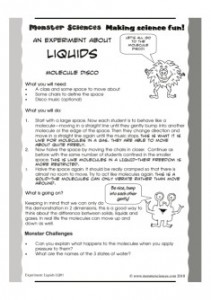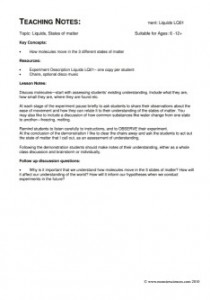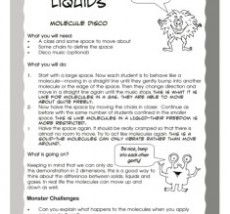Learn all about how molecule move in this fun liquids science experiment that’s more like a dance party!
 |
 |
What you will need:
- A class and some space to move about
- Some chairs to define the space
- Disco music (optional)
What you will do:
Start with a large space. Now each student is to behave like a molecule—moving in a straight line until they gently bump into another molecule or the edge of the space. Then they change direction and move in a straight line again until the music stops. This is what it is like for molecules in a GAS. They are able to move about quite freely.
- Now halve the space by moving the chairs in closer. Continue as before with the same number of students confined in the smaller space. This is like molecules in a LIQUID—their freedom is more restricted.
- Halve the space again. It should be really cramped so that there is almost no room to move. Try to act like molecules again. This is a solid—the molecules can only vibrate rather than move around.
What is going on?
Keeping in mind that we can only do this demonstration in 2 dimensions, this is a good way to think about the difference between solids, liquids and gases. In real life the molecules can move up and down as well.
Monster Challenges:
- Can you explain what happens to the molecules when you apply pressure to them?
- What are the names of the 3 states of water?
Teaching Notes:
Topic:
Liquids, States of matter
Key Concepts:
How molecules move in the 3 different states of matter
Resources:
- Experiment Description Liquids LQ01– one copy per student
- Chairs, optional disco music
Lesson Notes:
Discuss molecules—start with assessing students’ existing understanding. Include what they are, how small they are, where they are found etc.
At each stage of the experiment pause briefly to ask students to share their observations about the ease of movement and how they can relate it to their understanding of the states of matter. You may also like to include a discussion of how common substances like water change from one state to another—freezing, melting.
Remind students to listen carefully to instructions, and to OBSERVE their experiment.
At the conclusion of the demonstration I like to clear the chairs away and ask the students to act out the state of matter that I call out, as an assessment of understanding.
Following the demonstration students should make notes of their understanding, either as a whole class discussion and brainstorm or individually.
Follow up discussion questions:
- Why is it important that we understand how molecules move in the 3 states of matter? How will it affect our understanding of the world?
- How will it inform our hypotheses when we conduct experiments in the future?




